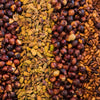10 High Fiber Low-Carb Foods Perfect for the Keto Diet

Unfortunately, the majority of Americans—more than 50 percent of people—do not get enough fiber in their diet [1].
This is a shame because dietary fiber is incredibly good for you, and can help improve your ability to lose weight, improve digestion, and even reverse or protect you from certain diseases [2][3][4].
So if you're on keto, now's a good time to look at how much fiber you're getting!
Here's a look at what fiber does for your body, what the term “net carbs” means, and 10 keto-friendly foods you can include in your diet to help up your intake and improve your health.
What Is Fiber?
Dietary fiber is the part of plant foods that resists digestion [5].Instead of being broken down by enzymes in the saliva and stomach, fiber passes through the gut into the small intestine and colon (at least somewhat intact), and then is eliminated through your stool. (There are different types of fiber, but for the sake of this article, we won’t go into them.)
Unlike other foods, whose nutrients are absorbed during the typical digestion process, fiber benefits the body because it gives the millions of tiny bacteria in your gut something to eat [6].
(This is why fiber-dense foods are famously associated with passing gas. The breakdown process in your small intestine releases gas that your body must expel.)
Americans are advised to eat between 19g and 38g of fiber per day to stay healthy [7].
Unfortunately, the most common foods we associate with fiber are typically not suited for a low-carb diet. Foods like cereal grains, bran, lentils, and beans simply contain too many carbs for people on keto.
But don't worry: there are high fiber foods you can eat on keto—and many benefits available if you do so.
Health Benefits of Eating Fiber
Here's what you stand to gain from eating enough fiber:- Weight loss: Fiber helps regulate appetite and keeps you full longer after meals. This is important if you're trying to shed excess fat because these things have been scientifically proven to help with weight loss and weight management [8].
- Improved gut health: As mentioned above, tiny microbes digest fiber instead of mouth and stomach enzymes. This keeps these tiny gut bacteria happy, healthy, and well-fed, which helps with a diverse range of things from aging to stress management [9].
- Improves blood markers: Dietary fiber has also been shown to improve blood pressure and cholesterol, both of which are used to determine disease risk [10][11].
- Lower risk of disease: Fiber helps regulate the metabolism and immune system, which is why scientists call it an essential nutrient for fighting or reversing the effects of diseases like cancer, heart disease, and type 2 diabetes [12]. It also helps reverse chronic inflammation throughout the body, which can also lead to these ailments [13].
How Fiber Content Impacts Net Carbs
Perhaps you've seen the term 'net carbs' before in low-carb diet circles. For example, on the keto diet, you restrict carb intake to 50 grams of net carbs per day [14].Net carbs is a simple calculation: Total Carbohydrates - Dietary Fiber - Sugar Alcohols = Net Carbs
For example: 25 total carbs in a meal replacement bar - 6 grams of fiber - 4 grams of sugar alcohols) = 15 grams of net carbs.
Fiber impacts net carbs because it slows the rate at which sugar enters your bloodstream [15].
When lots of sugar enters the bloodstream all at once, it can spike your insulin levels (insulin is a hormone that regulates blood sugar) [16].
(Think about it this way: candy and whole grain bread are both technically "carbs," but candy is pretty much all sugar and contains no fiber, unlike whole grain bread. Therefore, it will be broken down faster, causing a bigger spike of insulin)
When you replace sugars with dietary fiber or sugar alcohols—technically carbs in their own right, but not ones that will spike your blood sugar—you effectively lower the number of carbs you're eating.
Thus, fiber is an especially effective tool for anyone counting carbs, as it may allow you to eat some of your favorite foods without going overboard or getting knocked out of ketosis.
10 Low-Carb Foods that are Good Sources of Fiber
Here are 10 keto-friendly foods that contain lots of dietary fiber. Try to include them in your diet as often as you can!1. Avocados
- Carbs: 19.9g (per one cup) [17]
- Fiber: 15.6g
- Net carbs: 4.3g
2. Almonds
- Carbs: 10.3g (per half cup) [18]
- Fiber: 5.8g
- Net carbs: 4.5g
3. Raw Coconut
- Carbs: 12g (per one cup) [19]
- Fiber: 7.2g
- Net carbs: 4.8g
4. Blueberries
- Carbs: 9.9g (per 50 berries) [20]
- Fiber: 1.6g
- Net carbs: 8.3g
5. Cauliflower
- Carbs: 5.3g (per one cup) [21]
- Fiber: 2.5g
- Net carbs: 2.8g
6. Broccoli
- Carbs: 6g (per one cup) [22]
- Fiber: 2.4g
- Net carbs: 3.6g
7. Asparagus
- Carbs: 5.3g (per one cup, chopped) [23]
- Fiber: 2.8g
- Net carbs: 2.5g
8. Red Cabbage
- Carbs: 6.6g (per one cup, raw, chopped) [24]
- Fiber: 1.9g
- Net carbs: 4.7g
9. Mushrooms
- Carbs: 2.3g (per one cup—low even without the fiber!) [25]
- Fiber: 0.7g
- Net carbs: 1.6g
10. Zucchini
- Carbs: 4.2g (per one cup) [26]
- Fiber: 1.4g
- Net carbs: 2.8g
Keto Recipes Featuring High Fiber Ingredients

Finally, if you're feeling inspired to start eating more fiber, we encourage you to try one or more of our favorite high-fiber, low-carb recipes. Enjoy!
Breakfast
Lunch/Dinner
- Keto Pesto Chicken with Zucchini Noodles
- Steak and Avocado Keto Salad
- Homemade Keto Fish Cakes
- Keto Broccoli and Cheese
Sides
Desserts
For more high-fiber recipes and delicious keto-friendly meals, visit our recipe section!Fiber Does A Body Good
We hope you’ve been convinced to take steps toward increasing your fiber intake. It comes with many health benefits that you can enjoy in the short and long term. Plus, there are many fiber-rich foods and recipes that are delicious, so it shouldn’t be too difficult to do!-
Posted in
Authority Article, Keto Foods, Low-Carb Diets, Nutrition, Nutrition Article, Starting Keto




